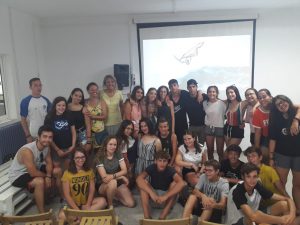Hi everybody! Ahir ens va venir a visitar la Conxi Rodríguez Prieto, professora titular de de la Universitat de Girona (UdG) del departament de Ciències Ambientals. La seva línia de recerca tracta sobre taxonomia i ecologia de macro algues marines.
La Conxi ens va explicar les diferents característiques del paisatge submarí del Mediterrani que el fan tan diferent dels altres oceans del planeta. Una de les diferències entre el nostre mar i els altres és que no hi ha tanta profunditat, fent així possible que s’escalfi i es refredi més ràpidament que els altres oceans.
Una altra característica és la capacitat de biodiversitat que hi habita, ja que té dos tipus de fons marí el dur i el tou. El fons dur és bàsicament roca per tant te una estructura sòlida ideal perquè els animals i les plantes creixin correctament. En canvi el fons tou al tenir una estructura poc sòlida i al ser de sorra amb els corrents es mou i fa que no és puguin arrelar les plantes. A més a més, el mediterrani és l’únic mar que té coral·ligen, una bomba de vida, és una estructura basada en els esquelets de la mateixa alga la qual va creixent per damunt. Als coral·lígens hi habiten milers d’espècies que busquen refugi, normalment espècies que s’estan extingint per la sobre pesca, per exemple, els meros o les llagostes.
I per acabar al mediterrani hi ha 6 prats de posidònia i al món sencer n’hi ha 59. Aquesta planta marina està en greu perill d’extinció, ja que cada vegada n’hi ha menys per culpa de la sobre pesca i del mal ús que causem al mar. El gran problema de la posidònia és que creix a una velocitat molt lenta. Les plantes que trobem han tardat uns 100 anys a créixer, si les destrossem, ja no hi ha marxa enrere. Així que entre tots intentem cuidar el nostre planeta.
Gràcies Conxi per la visita! Fins a una altra!

Hi everybody! Yesterday we got a visit from Conxi Rodríguez Prieto, she is a Professor at the University of Girona (UDG) in the department od Environmental Science. Her reasearch lines are taxonomy and ecology of marine macroalgae.
Prof. Conxi explained the different characteristics of the Mediterranean submarine landscape that make it so different from the other oceans and seas on the planet. One of the differences between our sea and the others is that it is more shallow, so the temperature fluctuates more easily.
Another feature is the biodiversity capacity, since it has two types of seabeds: hard and soft. The hard seabed is mostly rock, so it has a solid structure ideal for animals and plants to grow properly. On the other hand, the soft seabed has little solid structure and is mostly sand, so the sea currents make it harder for algae to sprout roots and create optimal habitat for animals. In addition, the Mediterranean is one of the few seas that has a coral reef. A coral reef is a “life bomb” of the habitats. It is made of the skeletons of the same corals, that live on the surface of the reef and due to many nooks and cranies it is a perfect location for different animals to live and hide. There are thousands of species that look for shelter in coral reefs, usually the species that are being threathened with extintion because of human overuse of the sea.
Prof. Conxi finished her class with some interesting and concerning facts about an algae called Poisidonia. There are 6 meadows of Posidonia in the Mediterranean and there are 59 in the whole world. This marine plant is in serious danger of extinction, because of over-fishing and other activities. The biggest problem that posidonia is faced with is that it grows at a very slow speed. The plants we can find in the sea today have taken 100 or more years to grow and if we destroy them, there is no easy way back. So we should all try to take care of our planet.
Thank you Conxi for the visit! Until next time!
